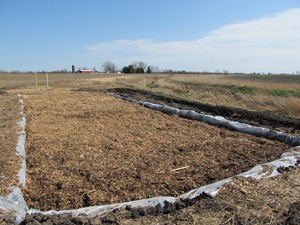The Embarras River

Embarras River at the outlet of the watershed. This is the USGS flow gaging site near Camargo, Illinois. We sample here every week, and every day at high flows to determine how much nitrate leaves the watershed. On the water quality data page we show the long-term pattern of nitrate in the watershed.
Wetland (factsheet)

This is one of our wetlands, along with a buffer strip along the river. A tile was diverted into it, and nitrate is removed before it flows into the Embarras River, which is in the background. The longer the water can stay in the wetland, the more nitrate is removed. These wetlands also provide habitat for ducks and other wildlife. Two videos are available: video 1, video 2.
Bioreactor (factsheet)

This is a tile bioreactor installed in the watershed (March 2012). Tile flow is diverted in and out of a trench, lined with plastic, and filled with wood chips. This helps to remove the nitrate. A video about bioreactors can be viewed here.